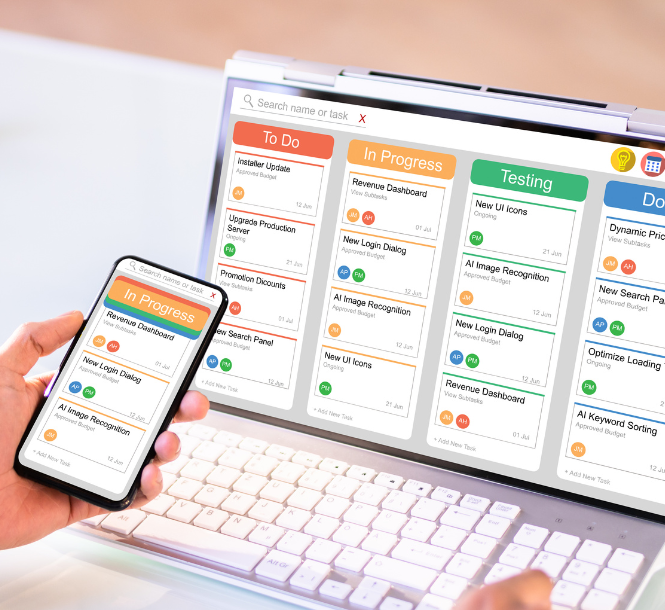Blog | The Great 28: Top digital tools to help you work smarter and faster – not harder
In today’s innovative digital world, your business can benefit enormously from the vast array of online tools at your disposal, boosting your efficiency and productivity.
However, most businesses are not getting maximum benefit from these tools. This is, of course, understandable – there are so many options to choose from, and it can be difficult to know where to begin. Many business owners are faced with practical obstacles, such as lack of time to invest in integrating the tools and a lack of information around which ones might be effective and efficient for them.
While larger companies may need advanced and costly tech solutions to serve functions such as marketing, sales, customer service and internal operations, SMEs like yours can take advantage of many similar solutions at low cost to fit within your budget, whether you’re operating in a B2B or B2C environment.
The good news is that many of these tools are incredibly easy to use, and don’t take much time to get to grips with – many are simply apps on your phone.
Nor are they costly, as many of them are free or cost only a budget-friendly amount each month or year (many have the option to pay a little more to upgrade to more advanced features). Yet they all have the power to streamline your business.
You may be worried about finding the time to learn how to use them and integrate them into your business. But the truth is, these tools have the potential to save you a huge amount of time.
In fact, by digitising and even automating some of your processes – particularly with AI – you might even find that it’s almost like having an extra employee!

To help you get started, we’ve selected some of the best options to give you top 28 tools to help you work smarter and grow faster. While this is by no means an exhaustive list, we think you’ll find it a great selection of practical, popular and proven tools to help you drive your business forward.
Admin tools
1. Dropbox
If you need to share large files or documents with clients or vendors, Dropbox is an excellent solution. Email platforms have size limits for attaching documents, but Dropbox allows you to send and share files quickly and easily however large they are.
Dropbox has desktop apps for Microsoft Windows, Apple macOS and Linux, as well as mobile apps for smartphones and tablets. You can also automatically upload photos or videos from a range of devices.
It offers the option of a free account (with a 2 GB storage limit), while upgrading to the paid Dropbox Business subscription plan offers 9 terabytes of storage for teams of three (or more) users.
2. DocuSign
Increasingly, customers want automated contracts and agreements. DocuSign allows you to do just that. The service offers eSignature – a quick way to sign electronically on various devices.
Speed is an essential factor here, with digital agreements cutting out the delay of physically posting and returning documents. Apart from saving workload (printing, scanning and mailing documents), it’s a convenient way to ensure deals get over the line.
Trust and security are also crucial – signatures processed by DocuSign are compliant with the US ESIGN Act and the EU’s eIDAS regulation, including EU Advanced and EU Qualified Signatures.

3. Calendly
Syncing up calendars to find a time to meet can quickly turn into an endless email back-and-forth. Calendly integrates with your existing calendar (including Google, iCloud and Outlook) then creates scheduling links based on your availability. This allows colleagues or customers to book time with you in one click.
You can also create different event types and times – be it a 15-minute consultation, or a more in-depth one-hour session.
Calendly offers a free plan with basic scheduling and integration features that are quite useful. However, if you want to add multiple meeting types and manage several calendars, stepping up to at least the $10 USD “Standard” level is recommended.
Project management tools
4. Slack
Slack is a great tool for team collaboration, which operates like a large chat room for a whole team. It can largely replace email as the team’s main method of communication and information sharing. Its workspaces allow communications to be organised by topic and private groups, for sharing information and files in one place.
Slack has a user-friendly dashboard, and as the messaging is quicker and a bit more casual than email, it provides a great digital environment to work with colleagues day-to-day. This could include sharing new business ideas, sending quick project updates or useful pieces of content. Colleagues are constantly kept in the loop, wherever they are.
Content is searchable within the platform, including files, conversations and people. Slack teams allow communities, groups or teams to join a “workspace” via a specific URL or invitation sent by a team admin or owner. Slack has a range of packages at different prices – including a free tier for trying out the software.
5. Asana
Team members often need to work on one part of a larger project and a tool to manage an overall project is Asana. This very practical tool helps teams to manage projects and tasks within one platform. It is designed to improve teamwork and streamlines work management, therefore helping to boost efficiency.
Teams can create projects, assign work to colleagues, specify deadlines and send messages about tasks directly in the system. Typical examples include assigning content work to graphic designers or assigning content writing or editing tasks.
Its simplicity is a big advantage, while it also keeps the workflow moving within a team and ensures accountability by keeping a centralised record of tasks. It’s completely free to use for up to 10 teammates under the Personal package, so is a very realistic option for SMEs.
6. Trello
Project management tool Trello lets you stay on top of everything you need to do by visualising your tasks and workflow. It gives you an easy way to divide your To Do list into stages (columns), with individual tasks on digital cards that you can drag and drop from one stage or column to the next depending on where it is in the workflow (for example, stages might be ‘incoming’, ‘do today’, ‘in review’ and ‘invoiced’).

Each individual task can be opened to add notes and deadlines, as well as checklists and comments, and you can assign them to individual members of your team.
Trello’s pricing includes a free basic option that provides all the core features, while the paid Standard plan includes more advanced features. Keep in mind: Each paid Trello plan is priced per user. For instance, if the standard plan is $5 USD per user, your total would be $15 USD per month for three users on your team.
HR tools
7. Bamboo HR
From hiring someone new and onboarding them to conducting annual performance reviews, Bamboo HR helps you manage every stage of the employee lifecycle. It gives you a secure place to store employee records, keep track of annual leave requests and it has a timesheet function if that is relevant for your business.
This platform was built with SMEs in mind which make up 89% of their customers. You can check out which package is most suitable for your business.
8. ExpenseIn
You probably already have an informal system in place for logging your business expenses, but if you’re still relying on an excel spreadsheet or paper receipts, digitising this area of your admin could save you valuable time. That’s where ExpenseIn can help.
ExpenseIn is a tool that saves time for both you and your employees when it comes to recording expenses, mileage and other business spending. All the employee has to do is to take a picture of their receipt and upload it to the app. From the employer’s point of view, expense categories can be set to match your line-item accounting and VAT rates are automatically calculated.
Expenses can be logged and approved in record time online, and you’ll also be able to generate reports to show you instantly where money is being spent.
As for pricing, ExpenseIn’s subscription plans only charge for users that are actively using the app – whether that’s one user or 10.
Marketing and social media tools
9. Hootsuite
Hootsuite is a social media management platform that lets you run multiple social media channels. It unifies social media strategy and outputs for a business within one platform, building your audience engagement and gathering key insights. Businesses will benefit from the organisation and structure it brings to this process.
Hootsuite supports social network integrations for Twitter, Facebook, Instagram, LinkedIn, Google+ and YouTube. Customising the dashboard can save a huge amount of time compared to running multiple social accounts individually. The platform offers free 30-day trials and a range of paid plans, escalating in cost and sophistication.
10. Canva
If you need to create visual content such as social media graphics, videos, presentations, posters and other assets, Canva is a brilliant graphic design tool available on web and mobile and providing millions of images, illustrations, fonts and templates. It has an extensive range of beautiful-looking templates for business flyers, brochures, business cards, logos, posters, infographics and more.

The free package gives you a lot to work with, but for an annual fee, the ‘Pro’ and ‘Enterprise’ options offer plenty of useful perks, including deeper customisation, unlimited premium templates, branding kits and AI-powered creative tools.
11. Mailchimp
Email is a key marketing channel for many businesses, as it’s a great way of connecting with your customer base, send them information, news and offers.
Mailchimp is a popular email marketing tool for large and small companies alike. It facilitates and manages digital communication and marketing with clients and customers, providing well designed campaigns and powerful data analysis.
You can design personalised email campaigns using their template options and send different emails to different types of customers by segmenting your contact lists. Their free plan caters for up to 2,000 contacts and 10,000 emails per month – a viable option for many SMEs running weekly, monthly or seasonal campaigns and promotions.

Creative tools
12. Adobe Lightroom
Boasting a powerful, yet user-friendly set of editing tools, Adobe Lightroom is an excellent choice for sprucing up, adjusting, and organising all the photos needed for your website and social channels. Think of Lightroom as the far less demanding, yet equally capable sibling of Photoshop.
For photo fixes on the go, Lightroom also provides 1 TB of cloud storage and a well-designed mobile app for smartphones and tablets. Monthly plans start at €12.29 per month or €146.71 per year.
13. Clipchamp
Producing engaging video content for your social channels shouldn’t be ultra-costly or time-consuming. Clipchamp is a beginner-friendly video editor that features an array of ready-made templates, visual effects, and free stock imagery for creating Instagram reels, Facebook video ads, TikToks and more.
Clipchamp is free to use, but upgrading to the premium plan for $12 USD/month gives you higher video resolutions, premium effects and a “brand kit” of logos, colours and fonts.
14. Podcastle
Podcasting can be an excellent (and cost effective) way to share your valuable insights with customers and create a library of on-demand content. But often, as a business owner, it’s a matter of having the time.
Podcastle is a user-friendly all-in-one solution for recording, editing, transcribing, and publishing professional-sounding podcasts. Plus – you can use built-in AI tools to remove background noise and long pauses so that you and your podcast guests always sound their best.
The free plan gives you up to three hours of recording time – perfect for recording a few podcast episodes. But if you’re planning to delve more deeply, then the Pro tier at $23.99 provides a far more complete set of studio tools.
Office tools
15. Office 365
If you think about “office productivity tools,” there’s a good chance Microsoft Office is what immediately springs to mind. The gold standard for decades, Office 365 has moved with the times and offers its flagship software, Word, Excel, PowerPoint and Outlook – as online, desktop and mobile apps. Tying the whole experience together is OneDrive, which seamlessly backs up and synchronises your files across devices.
The free version of Office 365 allows you to use web-only versions of their apps and even provides a small amount of cloud storage. For a fuller experience, step up to the Business Standard plan at $12.50 USD/month. This gives you the complete set of desktop, web and mobile apps and OneDrive storage.
16. LibreOffice
For some, the feature-richness (and monthly subscription price) of Office 365 might seem like a bit much. A great alternative here is LibreOffice – a completely free and open-source office software suite. Feature-wise, LibreOffice is no slouch, boasting its own mirror versions of Word (Writer), Excel (Calc) and PowerPoint (Impress).
File compatibility with other word processors is also strong, and you can save LibreOffice documents in other formats, so nothing gets lost in translation.
As mentioned, LibreOffice is free, but you can donate to support future development efforts.
Customer service and sales tools
17. Zendesk
Zendesk is a cloud-based customer support platform helping businesses offer better customer experience by connecting with customers on any channel, including phone, chat, email and social media. It unifies customer interactions in one simple platform, letting you track support requests and answer questions from customers quickly.
Zendesk offers advanced customer relationship management (CRM) tools to keep on top of customer support demands and is scalable for businesses of different sizes. The platform is focused on providing better efficiency within the team and improving the customer experience (CX). It offers free trials at the outset.
18. Hubspot
Hubspot is a CRM platform that allows you to manage sales, marketing, and customer service in one place. Features such as lead generation, marketing automation and customer feedback all help you stay on top of numerous aspects of your business.

From running marketing campaigns to turning leads into sales and turning sales into happy repeat customers that grow your business, Hubspot helps you do it all.
Prices for their Starter CRM software suite start at €30 per month.
19. Trustpilot
Reviews are crucial to building trust in your business and Trustpilot is a great tool for gathering them. It can be integrated into your website to allow customers to leave reviews of your products or services. The platform also gives you the ability to respond to reviews, along with insights to help you better understand your customers.
Trustpilot’s free plan provides many core features, like the ability to send review invitations and manage reviews. Upgrading to one of the monthly, paid business-oriented plans gives you a more powerful set of analytics and customer engagement tools.
Meetings tool
20. Google Calendar and Google Meet
As well as personal scheduling, Google Calendar is a quick and easy way to set up meetings, allowing you to send invitations to colleagues or clients and include the meeting location and agenda outline.
Pair it with Google Meet, a video conferencing tool that lets two or more colleagues chat online – it just needs a working camera and microphone on your PC or phone. Both Google Calendar and Google Meet are free, and you’ll find them in the Google suite.
21. Zoom
Everyone has grown very used to Zoom since the pandemic, and it remains a powerful tool for connecting with remote-working colleagues or business contacts from around the world.
It’s great for saving time and money over the cost of meeting in person, letting you schedule and conduct meetings from your desktop or phone and allows screen sharing

The basic plan is free, though group meetings have a 40-minute limit. You can also upgrade for larger and longer meetings, and for extra features such as recording.
22. Loom
“Can you see my screen?”
Five words uttered almost without fail during any online meeting.
Loom is a screen recording software that allows you to easily record video messages while sharing part (or all) of your display. Not only can Loom help streamline communications, but it can also be used to create support videos and tutorials that employees and clients can watch at their convenience.
The free, Starter plan allows you to record up to 5-minute videos. Choosing the $12.50 USD/month Business plan allows you to create unlimited length videos, while adding AI-powered features, like automatic transcription and titles.
AI-powered content creation tools
23. ChatGPT
Much has been made about ChatGPT and AI-powered chatbots, but what can they actually do for your business? One of the areas where ChatGPT truly shines is in content ideation and creation. Businesses have used the software to generate everything from sales advertising copy to blog posts and hiring letters.
For example, you can prompt ChatGPT by telling it to “write a 30 second promotional video script for a golf shop; use lots of golf-related puns.” The software will then generate a script that you can refine to your liking. This saves you from having to create something from scratch every time. Chat GPT is free to use. However, ChatGPT Plus (20 Euro a month) is considerably “smarter” than its free counterpart, and supports longer, more detailed prompts.
A word of caution: Used correctly, ChatGPT can be useful in terms of generating ideas and starting points for your marketing content. However, it’s far from perfect and is limited by the data and information it has been “trained” on. As a result, ChatGPT will sometimes create content that’s irrelevant, incorrect, or generic sounding. You will still need to do a thorough review and edit to ensure you’re putting your best content forward.

24. Google Bard
Google’s entry into the AI space is designed to function similarly to ChatGPT, in terms of answering questions and creating text based on user prompts. One major difference is that Bard pulls its information from the internet using Google’s formidable search engine technology. This makes Bard especially effective at researching and summarising information.
Bard is also free to use, with no paid tier currently. That said – the software is still considered an experiment by Google and can occasionally provide inaccurate information.
25. Grammarly
Typos, bad grammar and the wrong tone can be damaging for your business, especially when you want to portray your professionalism and make a good first impression. This is where Grammarly can help. It is an AI-powered writing assistant that reviews your spelling, grammar punctuation, and suggestions in real time.
Grammarly works as an app or browser extension on several different platforms.
The free basic plan is very good. However, to step up your writing game, you might want to check out the paid plans which offer more features such as plagiarism detection, fluency, tone adjustments, word choice and clarity-focused sentence rewrites. The tool is a must for businesses doing a lot of content marketing or professional writing.
Accounts and payments tools
26. Quickbooks
Managing your company accounts doesn’t need to be a headache with a simple accounting tool like Quickbooks, which lets you create and send professional invoices, log expenses, manage payroll, submit VAT and more – either from your desktop or mobile phone.
The mid-level Essentials plan costs €25 a month.

27. Revolut
Revolut is a handy tool for businesses who operate locally and globally and need to save money on sending or receiving payments, giving you business banking at market-leading rates.
Whether you’re paying employees who are based abroad or receiving bank transfers from customers, it takes minutes to set up and you can start using it immediately.
There’s a free option, but to get basic features you’ll need to pay a monthly fee, which starts from €19 a month (with an annual plan) and includes a certain number of free international payments each month.
28. SumUp
Customers who have traditionally paid in cash for household services such as gardeners, electricians are increasingly expecting to be able to pay by card. If you need an easy way for your business to take card payments, the answer is SumUp, which lets you accept card payments for a 1.69% fee per transaction, wherever you are.
This is ideal if you run a business, that means you’re always on the go – for example, a plumbing business, taxi service or market stall – and need a quick way to take payments from customers when you’re attending a job.
Their entry-level Air card reader costs €49, pairing with your smartphone and letting you have a free online business account to track your payments.
For a one-time purchase of €339 (excluding VAT), you can get SumUp’s POS Lite, which functions as a full, out-of-the-box point of sale solution. This sets you up to not only process payments, but also create item catalogues, track your sales history and issue payment receipts.
Conclusion
Digital and AI-powered tools really can be your ‘invisible employee’, saving time and money, as well as growing customer numbers and loyalty. If your business can leverage them to work smarter, the time invested to introduce and integrate them will be paid back many times over. It will also improve your customer experience, boosting your brand, reputation, and revenue.
Clever use of digital tools can streamline and improve efficiency within your business, while also freeing up much-needed time for you to concentrate on other important areas of the business.
Further reading
Get lots more advice on growing your business at our SME Start hub, or head to SME Evolve for insights to help you take your business further.
Oonagh McCutcheon is our Corporate Communications Manager and National Director of our .IE Digital Town Programme.